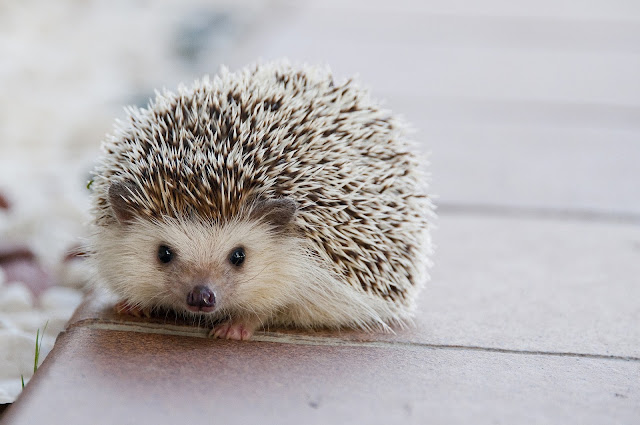Hedgehogs are interesting creatures that make unique pets. Besides the fact that they eat a totally different kind of food when contrasted with other pocket pets, however they are covered with small spikes and roll into balls when frightened. Keeping a hedgehog as a bed requires extraordinary necessities, such as lodging and food, so read on to find the most ideal way to really focus on a pet hedgehog.
Hedgehog Statistics
- Name:African dwarf hedgehog
- Size: Five to eight inches long
- Life expectancy: Average of five years
Hedgehog Diet
Dissimilar to most other pocket pets, hedgehogs are viewed as insectivores, and these snouted critters have a remarkable preference for things that killjoy and creep. Mealworms and crickets are the most generally taken care of bugs in imprisonment yet the staple eating regimen for a hedgehog ought to be a locally acquired, extraordinarily figured out hedgehog kibble. It's significant, particularly on the off chance that your kibble image doesn't have bugs in that frame of mind, to enhance with live bugs, like mealworms and crickets, and veggies.
Numerous proprietors reproducers actually feed little cat food to their hedgehogs yet this isn't ideal since feline food doesn't contain blood dinner and chitin in it.
Keeping Hedgehogs as Pets
As their name infers, African Pygmy hedgehogs are local to focal and eastern Africa yet the greater part of these hedgehogs are really a crossover of two animal categories: the Four-toed and Algerian hedgehogs. In the wild, they likewise live fundamentally off of little bugs, grubs, snails, insects, and little vertebrates — an eating regimen you ought to endeavor to emulate in bondage.
Confines made for guinea pigs and hares are reasonable for hedgehogs however wire-grind confine bottoms ought to be kept away from since hedgehogs have little feet that will be harmed assuming they fall through these meshes. Delicate sheet material, for example, reused paper material or towels that are changed out consistently is best for the touchy feet of a hedgehog. Great cushioning for the enclosure is critical; wire-base or plastic meshes can prompt callus development on the feet, which can prompt foot contaminations known as pododermatitis. You should seriously think about downy or canine preparation potty cushions over the delicate cushioning or wool to clean specific regions without any problem.
A huge encased running wheel ought to be saved in the enclosure for your hedgie to practice in alongside a conceal box, food bowl, and water bottle. Ensure the running wheel is cleaned routinely to stay away from feces from developing which can cause foot contaminations or diseases in people after dealing with them.1
Hedgehogs are exceptionally dynamic around evening time and will run a few miles daily on their wheel or in their encased play region. In the event that they can't get a lot of activity they require they might become discouraged, overweight, and foster foot wounds. Exercise and action are vital to hedgehogs so potential proprietors ought to have the option to focus on having the option to give a hedgehog the space important to do as such.
Taking care of Hedgehogs
African dwarf hedgehogs clearly have a ton of thorny spines however that doesn't mean they aren't enjoyable to hold. Tame hedgehogs will creep into your hands, take treats from you and even appreciate a tad. More youthful hedgehogs are simpler to tame than more established ones, consequently your most obvious opportunity to have a hedgehog that loves being held is by becoming one at around six to about two months old enough.
Commonly, hedgehogs could do without their heads being pet and will move into spiked balls when terrified. Since hedgehogs honestly don't really like water, on the off chance that you are experiencing difficulty cleaning your hedgehog's feet, take a stab at setting it in a shallow shower that main covers their feet.
Hedgehog Health
Dental illness, skin issues including vermin and lice pervasions, digestive parasites, and growths can all be issues for pet hedgehogs.2 Spaying and fixing are prescribed to stay away from regenerative organ growths and different sicknesses sometime down the road. Careful dental assessments at the yearly vet visits and a periodic dental cleaning under sedation are prescribed to forestall your hedgie from losing any teeth or creating other dental issues. A few proprietors can clean their hedgehog's teeth utilizing feline toothpaste and a little head toothbrush or cotton-tipped utensil week after week however this is extremely phenomenal.
Corpulence is one more typical issue with these pets; ensure you feed the prescribed measure of food as indicated by the eating routine they are utilizing.
Spine misfortune is ordinary in limited quantities yet assuming that your hedgehog is losing such countless spines that it has bare patches it likely has a clinical concern. Parasite invasions, for example, bugs are the most widely recognized purposes behind exorbitant spine loss.2 If your hedgehog is losing a ton of spines then, at that point, it's the ideal opportunity for an examination with the vet.







.png)

.png)
.png)
.png)










